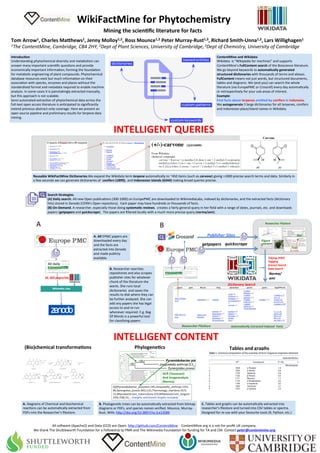WikiFactMine for Plant Chemistry
- 1. WikiFactMine for Phytochemistry Tom Arrow1, Charles Ma;hews1, Jenny Molloy1,2, Ross Mounce1,2 Peter Murray-Rust1,3, Richard Smith-Unna1,2, Lars Willighagen1 1The ContentMine, Cambridge, CB4 2HY, 2Dept of Plant Sciences, University of Cambridge, 3Dept of Chemistry, University of Cambridge Mining the scienGfic literature for facts All so&ware (Apache2) and Data (CC0) are Open. h9p://github.com/ContentMine . ContentMine.org is a not-for-profit UK company. We thank The Shu9leworth FoundaMon for a Fellowship tp PMR and The Wikimedia FoundaMon for funding for TA and CM. Contact peter@contentmine.org ContentMine and Wikidata Wikidata is “Wikipedia for machines” and supports ContentMine’s FullContent search of the Bioscience literature. We go beyond keywords to automaGcally generated structured dicGonaries with thousands of terms and aliases. FullContent means not just words, but structured documents, tables and diagrams. We (and you) can search the whole literature (via EuropePMC or Crossref) every day automaMcally or retrospecMvely for your sub-areas of interest. Example: Find facts about terpenes emi;ed by conifers in Indonesia. We autogenerate 3 large dicMonaries for all terpenes, conifers and Indonesian place/island names in Wikidata. IntroducGon Understanding phytochemical diversity and metabolism can answer many important scienMfic quesMons and provide economically important informaMon; forming the foundaMon for metabolic engineering of plant compounds. Phytochemical database resources exist but much informaMon on their associaMon with species, enzymes and places without the standardised format and metadata required to enable machine analysis. In some cases it is painstakingly extracted manually, but this approach is not scalable. Semi-automated extracMon of phytochemical data across the full-text open access literature is anMcipated to significantly extend previous abstract-only coverage. Here we present an open source pipeline and preliminary results for terpene data mining. Reusable WikiFactMine DicGonaries.We expand the Wikidata term terpene automaMcally to ~450 items (such as carvone) giving >1000 precise search terms and data. Similarly in a few seconds we can generate dicMonaries of conifers (1899); and Indonesian islands (6344) making broad queries precise. Search Strategies. (A) Daily search. All new Open publicaMons (300-1000) on EuropePMC are downloaded to WikimediaLabs, indexed by dicMonaries, and the extracted facts (dicMonary hits) stored in Zenodo (CERN’s Open repository) . Each paper may have hundreds or thousands of facts. (B) On-Demand. A researcher, especially those doing systemaGc reviews. creates a fairly general query in her field with a range of dates, journals, etc. and downloads papers (getpapers and quickscrape) . The papers are filtered locally with a much more precise query (norma/ami). Researcher FileStore Publisher Sites Tidying (PDF) Tagging Science Search Data Search AutomaBcally Extracted Indexed Facts getpapers quickscrape DicBonary Search Diseases Drugs Phytochem Species Norma/ ami Text Figure s Genes Dat a Researcher FileStore B All daily 30, 000 pages/day A A. All EPMC papers are downloaded every day and the facts are extracted into Zenodo and made publicly available. B. Researcher searches repositories and also scrapes publisher sites for whatever chunk of the literature she wants. She runs local dicMonaries and saves the results to disk where they can be further analyzed. She can add any papers she has legal access to and re-run whenever required. E.g. Bag Of Words is a powerful tool for classifying papers (Bio)chemical transformaGons PhylogeneGcs A. Diagrams of Chemical and biochemical reacMons can be automaMcally extracted from PDFs into the Researcher’s filestore. B. PhylogeneMc trees can be automaMcally extracted from bitmap diagrams or PDFs, and species names verified. Mounce, Murray- Rust, Wills: h9p://doi.org/10.3897/rio.3.e13589 Tables and graphs C. Tables and graphs can be automaMcally extracted into researcher’s filestore and turned into CSV tables or spectra. Designed for re-use with your favourite tools (R, Python, etc.) INTELLIGENT QUERIES INTELLIGENT CONTENT
